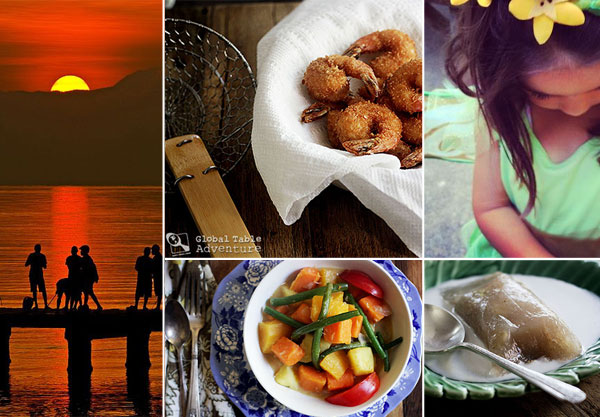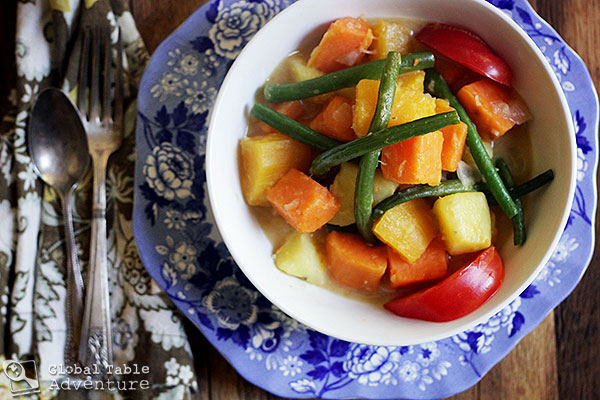I hover over the dining table, scooping the tapioca and banana mush onto banana leaves to make saksak. The deep green leaves are soft and supple – completely relaxed from a pass over the licking blue flames on my range. I work slowly, eventually rolling each leaf into a rectangle shape, taking care not to spill any filling. I tuck each bundle securely in the steamer and, when I’m done, I click on the burner. A few moments later, vapors slip out between the pot lid and the pot. Little wisps of banana scented air. The house smells beautiful. Real life: later that night no one would eat these little rectangles of chewy, slippery banana tapioca dumplings. No. One. I had retreated to work on my speech for the Tulsa Global Alliance’s Global Vision Dinner (350 attendees – eek!) and left them to eat this Global Table alone. When I check the fridge the next morning, the little green packets are still there. Forlorn. With shifty eyes, Keith claims he didn’t see them. Later, I …
Read More

Fact: Shrimp are like relationships. They should be warm and inviting. Not cold and clammy. I’ve never been a fan of cold shrimp at cocktail parties. I eat them begrudgingly (if only because I’m an eternal grazer). All the while, I daydream of a crackling, crusty, and “fried-until-golden-brown” shrimp. I’m not sure why I settle on cold and clammy at cocktail parties, but I do it every single time. Thankfully, I didn’t make the same mistake when choosing my husband. And, after this week’s Global Table, I may never do it again with shrimp. While you won’t find Coconut Shrimp in the remote villages of Papua New Guinea, you will find it in the country’s coastal restaurants. In fact shrimp would be the dainty option; often they’ll use humongous prawns and serve spicy chili sauce on the side for dipping. To give the shrimp authentic spice without sauce I added a sprinkle of brilliant cayenne… a spice the color of a Papua New Guinean sunset and a fishermen’s dream. Ingredients: 1 lb shrimp, peeled & deveined, tails on 1/3 cup …
Read More

I don’t make a lot of really, really weird things on this blog. You won’t see deep-fried tarantulas or monkey brains. This is because I feel strongly that regular people (and by that I mean regular-really-special-all-kinds-of-wonderful people like you), living in average towns (that they love with all their heart, like you do) should be able to replicate this adventure without pulling their hair out by the roots. Simply put: the more people cooking the world, the better. And I’m here to make it as easy as possible. That being said, sometimes I run across really strange recipes made with really normal ingredients. These are like culinary goldmines for the stovetop traveler. Unique learning experiences that are not an impossible nightmare to cobble together. Fun, fun, fun. Take today’s recipe from Papua New Guinea: Saksak, a.k.a. Sago Dumplings. This slippery treat is made with nothing more than tapioca, bananas and sugar, wrapped up in a banana leaf “blanket” and swimming in a warm coconut sea. I found everything for the Saksak in our grocery store except for the banana leaves. …
Read More
“I would eat that” says Mr. Picky, after taking a nibble off of my wooden spoon. I take a bite off the same spoon and let my eyes flutter shut. My mouth is filled with the most comforting, savory goodness. These coconut veggies taste exactly like a delicious hug on a rainy day… or a steaming hot shower after a rough and tumble game of basketball… or that happy dream you have after finishing a really, really great book (or show) – the kind of dream that lets the world of the characters continue on in your imagination. Good stuff. There’s nothing so softly seductive as sweet potatoes, butternut squash, potato, and green beans, simmered in creamy coconut milk with a touch of ginger and garlic. This is the quintessential Papua New Guinean meal – one you’ll often see ladled over white, somewhat mushy rice. Why mushy? Well, according to Caroline Leigh who has been to Papua New Guinea, rice cooked in thin aluminum pots is always mushy. Since almost all pots in Papua New Guinea …
Read More

“How can a country of 800 plus languages and 700 plus ethnic groups unite to form a country, impossible but possible for PNG” – Sir Michael Somare, Prime Minister of Papua New Guinea. (Source) Sir Michael Somare has a great point. How exactly does a group of people so diverse remain unified as a country? From what I’ve read, PNG’s success has a great deal to do with the freedom it allows these 700 ethnic groups to express themselves, whether by wearing unique clothing, performing culture-specific rituals, or enjoying local music. PNG makes room for it all. That being said, the peoples are surely united by one food in particular: the coconut. Every single dish on this week’s Global Table celebrates coconut for one simple reason – PNG loves the coconut. In my research I found it shows up in almost every recipe. (Update: turns out Brian S.’s trip to the interior of PNG did not feature the coconut, so perhaps this is just a coastal thing). Considering I can’t get my family to agree …
Read More
Few sentences succeed at stopping me in my tracks, however last night’s research on Papua New Guinea made me blush and chuckle. I can’t help but share the line that made me react so strongly, as it sums up the culture more succinctly than three pages worth of blabber I could offer: A young bare-breasted woman recently bought as a bride for five pigs may be wearing a digital wristwatch. (1000 Places to See Before You Die) Knock that image around your brain a while. As far as mental images go, the digital wristwatch really is the cherry on top – a snapshot of a bygone era in American style, circa 1980, which is now firmly lodged in the “outdated” category this side of the Pacific. I love every bit of it. As for the pigs – yes, they are so valuable that many tribes use them as currency. The book goes on to describe several regions of Papua New Guinea celebrated for even more dramatic isolation. So untouched by modern influence, these communities remain submerged …
Read More







